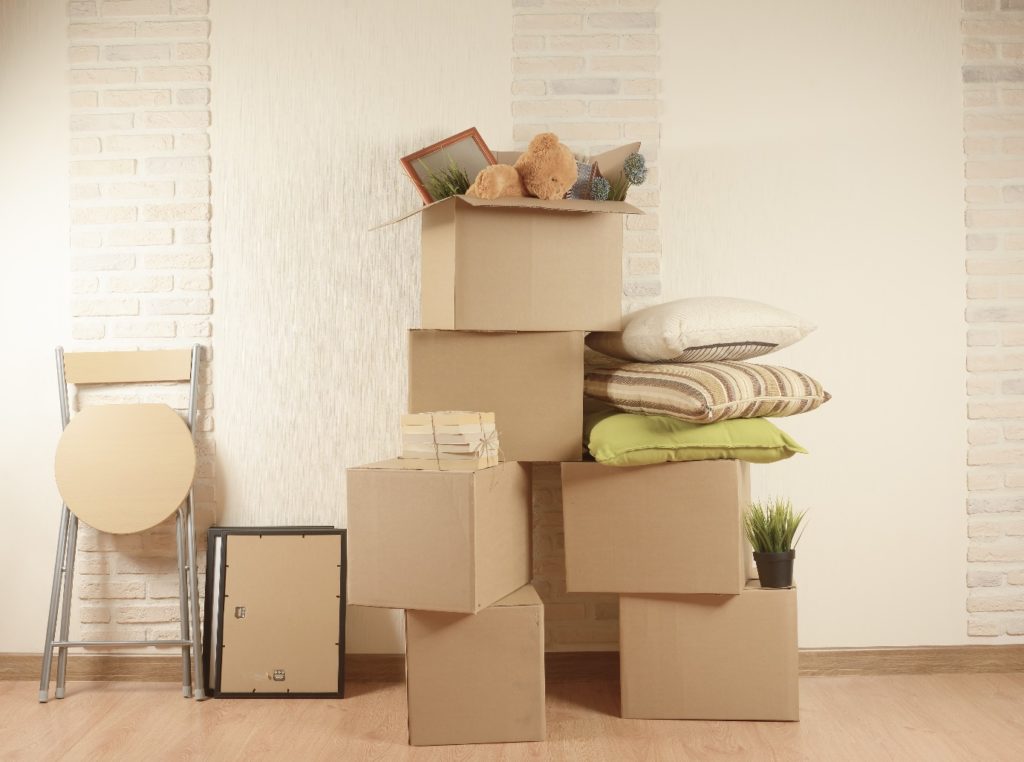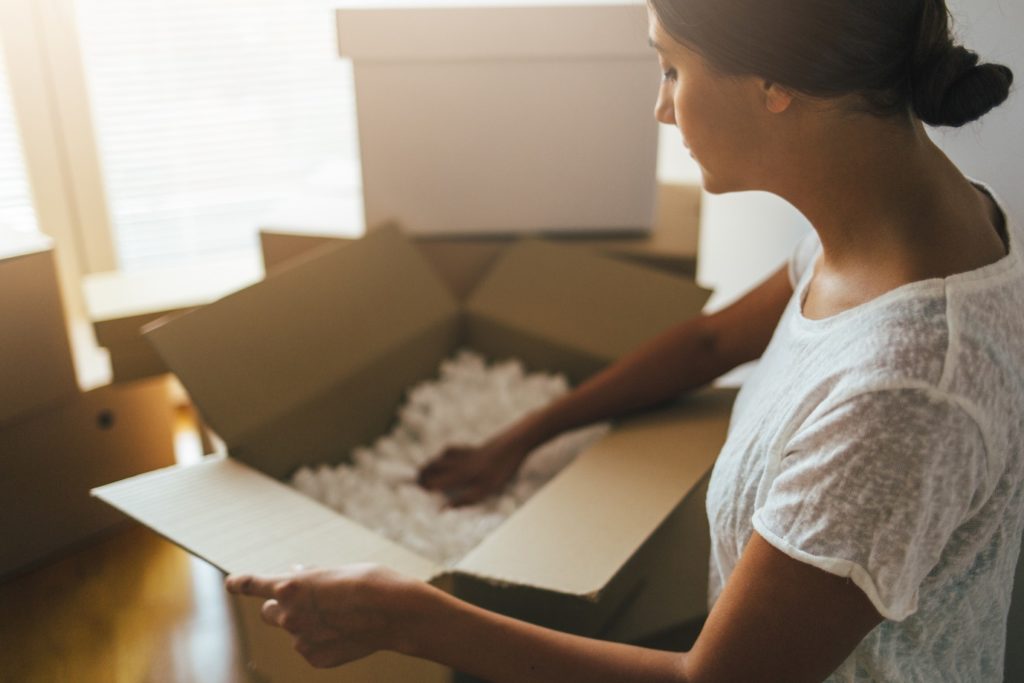How Pack and Go Storage Simplifies Your Move
Choosing a portable storage container is a smart move. You get to skip the entire hassle of renting and driving a huge truck. The beauty of storage on the go is that the container comes right to you. You fill it on your own schedule, and we handle the rest. But now for the crucial part: packing it correctly. Since your container will be moving, how you load it makes all the difference. This isn’t just about stacking boxes. We’ll walk you through the essential tips for successful pack and go storage, ensuring everything arrives safe and sound.
When using a storage container instead of traditional storage, though, there are a few differences in the way you should pack. With the right adjustments, you can fit more into your portable storage container and still keep everything safe.

How Does Pack and Go Storage Work?
When you book your portable storage unit, you’ll nominate a day and time to receive the container. When that time comes, the storage company will deliver the container and lay it out on a piece of level ground. Make sure you have room and permission to put it there and be aware of any local regulations which may restrict the amount of time you can keep it on or near your property.
Understanding the Costs of Portable Storage
When you start shopping for a portable storage container, you’ll quickly notice that pricing isn’t always straightforward. The final cost depends on several factors, including the size of the container you need, how long you’ll need it, and the distance it needs to travel. Some companies rent by the month, which gives you the flexibility to pack and unpack on your own schedule without feeling rushed. This is a huge plus if you’re trying to reduce the stress of moving. The key is to understand exactly what’s covered in your initial quote so you can accurately compare your options and avoid any last-minute surprises on your bill.
What’s Included in Your Quote?
A quote is more than just a number; it’s a breakdown of the services you’re receiving. A comprehensive quote should ideally include the container rental fee, delivery to your location, transportation to a storage facility or your new home, and final pickup. However, this isn’t always the case. Some companies present a low initial rental fee but then add on separate charges for delivery and transport. It’s essential to ask for an all-in price to get a true sense of the cost. Knowing what’s included helps you compare apples to apples and ensures you’re choosing a service that values transparency and convenience, simplifying your move from start to finish.
Comparing Pricing Models
Different companies structure their pricing in different ways. For most, the cost is heavily influenced by the distance of your move and the size of the container you choose. For example, a company like U-Haul might advertise a low monthly fee for its U-Box, but that price often doesn’t include critical services like delivery, transportation, or even basic damage insurance. These are all added on later, which can significantly inflate the final price. In contrast, other providers may offer a more inclusive quote that bundles these services together. Always clarify if your quote includes everything you need for a smooth, hassle-free experience.
Watch Out for Hidden Fees and Deposits
Nothing sours a moving experience faster than unexpected fees. Before you commit, ask directly about any potential extra charges. These could include fuel surcharges, late fees, or taxes that weren’t in the initial estimate. Another important factor is the security deposit. Some companies, like 1-800-PACK-RAT, may require a hefty deposit of up to $500 for long-distance moves. Others, like PODS, don’t require a deposit at all, with payment due just before your container arrives. At Box-n-Go, we believe in clear, upfront pricing without the need for a deposit, because your move should be as simple and stress-free as possible.
How to Save Money on Your Move
While convenience is a top priority, everyone wants to find a good deal. The single best way to save money is to compare prices from at least three different companies. Getting multiple quotes will give you a clear picture of the market rate for your specific needs. Another pro tip is to book as far in advance as possible. Making a reservation early can often secure you a better rate, especially during peak moving seasons like summer. Also, be realistic about the container size you need. Paying for space you don’t use is an easy way to overspend, so take the time to estimate your inventory before booking.
Comparing Popular Portable Storage Options
Once you have a handle on the costs, it’s time to look at the containers themselves and the companies that provide them. Not all portable storage units are created equal. They vary in size, construction material, and durability, which can impact the safety of your belongings. Some are made of steel for maximum security, while others might use a combination of wood and weatherproof covers. The company you choose also matters, as their service areas, unique features, and customer support can make or break your moving experience. Let’s look at how some of the big names in the industry stack up against each other.
Container Details: Size, Materials, and Rental Time
The physical container is at the heart of your rental. U-Haul’s U-Box, for instance, is one of the smaller options, holding about 257 cubic feet. In contrast, U-Pack’s ReloCube is slightly larger at 308 cubic feet and can hold more weight. This difference might seem small, but it can be the deciding factor between needing one container or two. Most companies offer monthly rentals, giving you ample time to load your items. At Box-n-Go, our containers are designed for ground-level loading, so you can walk right in without struggling with a ramp—a small detail that makes a huge difference on moving day.
U-Pack vs. U-Haul U-Box
When comparing U-Pack and U-Haul, value is a key differentiator. While U-Haul’s U-Box might seem cheaper at first glance, U-Pack’s ReloCube often provides a better overall value. According to U-Pack’s own comparisons, its pricing is typically more inclusive, bundling services like delivery, transport, and basic insurance that U-Haul often charges for separately. This means the price you’re quoted by U-Pack is closer to the price you’ll actually pay. The ReloCube is also larger and more robust, offering more space and better protection for your belongings during transit.
PODS vs. 1-800-PACK-RAT
PODS and 1-800-PACK-RAT are two of the most well-known names in the business, and they are very competitive. Both offer all-steel, weatherproof containers in multiple sizes, making them great choices for security and durability. While some analyses name 1-800-PACK-RAT as a slightly cheaper option overall, the best choice often comes down to your specific location and the details of your move. It’s always worth getting a quote from both to see who can offer a better deal for your circumstances. Remember to factor in things like deposit requirements and customer service reviews when making your final decision.
Unique Features and Services
Sometimes, a company’s special features can be the deciding factor. For example, PODS offers a unique hydraulic lift system called PODZILLA, which keeps your container level during loading and unloading to prevent items from shifting. They also have a “City Service” for navigating tight urban streets. These kinds of thoughtful services show a company understands the real-world challenges of moving. Here at Box-n-Go, we focus on providing a seamless experience by offering free ground-level access to your container at our secure facility, so you can retrieve items whenever you need to without any hassle or extra fees.
Service Availability and Locations
A great company isn’t much help if they don’t service your area. Before you get too deep into comparing quotes, your first step should be to confirm which companies operate in both your starting location and your destination. National brands like PODS have extensive reach, serving most of the United States with hundreds of storage locations. Smaller or regional companies might offer more personalized service or better rates but have a limited service area. Always verify availability on the company’s website or by calling them directly to ensure they can handle your entire move from door to door.
Getting Ready to Load Your Storage Container
You may think you can pack up your boxes much like any other move—in assorted shapes and sizes. You can do this, but you’ll be able to fit much more in your unit if you use the same size and shape boxes for all of your belongings. Get the exact inner dimensions of the unit before you start so you can figure out the best way to fit everything snugly.
As well as this, you’ll need enough reinforcement on the boxes themselves to withstand the weight of several layers. Tape up as many sides as you can, then do it again for good luck. The last thing you want is for the bottom layer of boxes to be crushed under the others.
How to Strategically Pack Your Container
You need to prepare for the fact that the container will be transported from your location to storage, and then from storage to your new location. No matter how careful the driver is, the contents of the container can shift and topple during transit if they’re not packed properly.
To help prevent this, you’ll need to:
- Pack your boxes tightly so there is little room to move.
- Make floor-to-ceiling “walls” of boxes along the sides and end of the container to prevent items shifting.
- Distribute the weight evenly throughout the unit, putting heavier items at the bottom.
- Use loading straps to tie down objects if the container comes with internal strap anchor points.

Protecting Your Fragile and Valuable Items
The number-one rule of irreplaceable items like documents and jewelry is to not pack them at all. Unlike secure, off-site storage units, you won’t be in control of your portable storage unit once it leaves your property. It’s best to keep these with you as you move.
Tips for Securing Your Breakables
Fragile items such as glass and delicate furniture can be packed into portable storage, but you’ll need to be careful. Use as much padding as you can and make sure they’re securely in a box or strapped to the floor of the unit. Some things you can use as padding include:
- Clothes
- Cushions
- Bedding
- Bubble wrap
- Old Styrofoam packaging
Do You Need a Climate-Controlled Unit?
Most portable containers don’t feature any kind of climate control, unlike traditional dedicated storage facilities. You’ll need to compensate for this, first by protecting all exposed furniture and fittings from the light and, second, by using moisture absorbers in the container to protect against damp and mold.
On-Site vs. Warehouse Storage
Once your container is packed, you have two main options for what happens next. The first is on-site storage, where the container simply stays on your property. This is a perfect solution for home renovations or any situation where you need constant access to your belongings. The second option is warehouse storage, where the company picks up your packed container and takes it to a secure, central facility. Companies like PODS offer this service, which is a lifesaver if you’re between homes or just need to declutter. At Box-n-Go, we specialize in this warehouse model. We’ll transport your container to our clean, indoor facility where you get free, ground-level access to your things whenever you need it—no appointments or hassle required.
Common Challenges with Container Moves (And How to Avoid Them)
Portable storage containers are a fantastic tool for moving and storage, but it’s always smart to be aware of a few potential hurdles. Knowing what to expect can help you plan better and ensure your entire experience is smooth and stress-free. The main things to prepare for are the potential for your items to get jostled during transport and the physical work required to get everything loaded up. While that might sound a bit daunting, a little bit of preparation makes all the difference in the world. Thinking through these common issues beforehand is the key to a successful move, so let’s break down how you can handle them like a pro.
Dealing with Delays and Damage
One of the biggest concerns people have is what happens to their belongings once the container leaves the driveway. As the experts at This Old House note, “the contents of the container can shift and topple during transit if they’re not packed properly.” This is exactly why the packing strategies we covered earlier are so important. Securing your items by packing boxes tightly and distributing weight evenly is your best defense against damage. Choosing a reputable company also makes a huge difference, as careful drivers and well-maintained equipment play a major role in getting your things from point A to point B safely. A good provider will have a low rate of damage claims, so don’t be afraid to ask about their track record before you book.
Managing the Physical Labor
Let’s be honest: using a moving container means you’re taking on the packing and loading yourself. It’s a great way to save money compared to hiring a full-service crew, but it does require some elbow grease. The good news is that you can make the job much easier on yourself. While you still have to load the container, using a service like Box-n-Go eliminates so many other physically demanding steps. You won’t have to rent a truck, deal with a clunky loading ramp, or do the exhausting work of loading your things into a truck only to immediately unload them into a storage unit. We bring the container right to you. You load it once, and that’s it. It’s all about working smarter, not harder.
Give Yourself Plenty of Time to Pack
The most important advice we can give is to not rush the job. The great thing about portable storage is that, once the container is on your property, you usually have all the time in the world to pack it. So, relax, plan how you’re going to do it, and take a few days to avoid damaging your stuff—or yourself.
In the same way, you should plan your move before it’s too late. You don’t want to be running around trying to organize your student self-storage in the dying days of the semester. Start a couple of weeks ahead and call Box-n-Go Moving and Storage at (877) 269-6461. As the experts on cheap and easy campus storage around USC and UCLA, we can take the headache out of any move, no matter how big or small.
Your Moving Timeline: When to Start Planning
Procrastination is the enemy of a smooth move. While the flexibility of portable storage means you aren’t tied to a rigid schedule, it’s wise to begin your planning at least a few weeks before your target moving date. This gives you a comfortable buffer to sort, declutter, and gather packing supplies without the last-minute panic. A key first step is to figure out where the container will go. Before you book your portable storage unit, take a moment to confirm you have adequate space and check for any local rules that might limit how long it can stay on your property. Getting this sorted out early prevents any unexpected hiccups and lets you focus on the packing itself.
Frequently Asked Questions
What’s the biggest mistake people make when packing a portable container? The most common misstep is not distributing weight evenly. It’s tempting to load all your heavy furniture first at one end, but this can make the container unbalanced and cause significant shifting during transport. A close second is not packing boxes tightly enough. Leaving large gaps allows items to slide and topple over. Your goal should be to create stable, floor-to-ceiling walls of boxes and furniture to keep everything locked in place.
How do I figure out what size container I actually need? Choosing the right size can feel like a guessing game, but you can get a good estimate by taking a quick inventory. Start with your largest items—sofas, beds, dressers—and then count up the approximate number of boxes you’ll have. Most companies provide a general guide, like “fits a one-bedroom apartment,” but for the best results, use their online space calculator or just give them a call. A quick conversation can save you from paying for space you don’t use or, worse, running out of room.
Is my stuff really safe once the container leaves my driveway? Yes, your belongings are very secure, especially when you take a few key steps. The containers themselves are built from steel and designed to be weatherproof, protecting your things from the elements. You also provide your own lock, so you are the only person with a key. The most important factor for safety, however, is your packing job. When you pack everything snugly and securely, you prevent items from moving around and getting damaged during transit.
What’s the real difference between keeping the container on my property versus at a warehouse? It really comes down to a choice between immediate access and freeing up your space. Keeping the container on-site is perfect for a home renovation project where you need to grab tools or items daily. Opting for warehouse storage is the ideal solution when you’re between homes or simply need to declutter your property. The company moves the container for you, keeping it in a secure facility until you need it delivered to your new place.
Do I need to be home for the container delivery and pickup? It’s highly recommended that you are present for the delivery. This allows you to show the driver the exact spot where you want the container placed, ensuring it’s on level ground and in a convenient location for you to load. For the final pickup, you typically don’t need to be there, as long as the container is locked, clear of any obstructions, and easily accessible for the truck.
Key Takeaways
- Get the real price, not just the rental fee: A low monthly rate can be misleading. Always ask for an all-in quote that includes delivery, transportation, and final pickup so you can accurately compare companies and avoid surprise charges.
- Pack for movement, not just for storage: Since your container will be transported, load it strategically. Create tight, stable walls with uniform boxes, place heavy items on the bottom, and use soft padding like blankets to fill every gap and prevent shifting.
- Plan your placement and timeline in advance: Before booking, figure out where you’ll put the container and check for any local rules. Giving yourself a few weeks to plan and pack eliminates last-minute stress and helps the entire process run smoothly.
Related Articles
- How to pack with professional results – a collection of packing tips to help you pack your valuables for your move | Box-n-Go Storage
- How much does it cost to rent a portable storage unit
- Traditional vs. Portable Storage – Box n Go Storage and Moving
- How to Pack Household Items For Storage or Moving | Box-n-Go
- How to Pack Your Living Room for Storage or Moving | Box-n-Go


